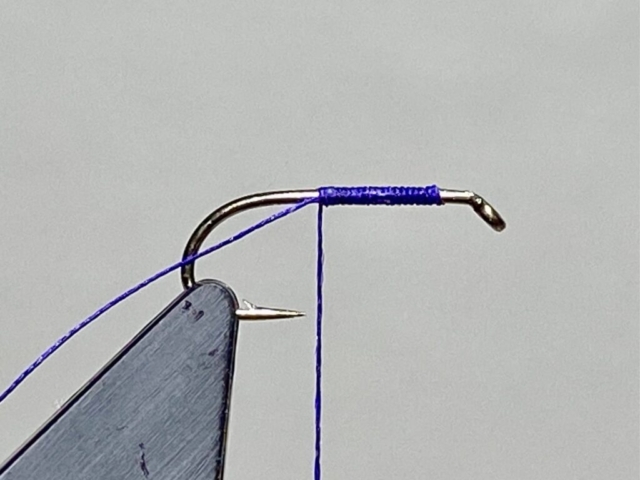
A Fly to Tie and Try August by Les Lockey
Fly of the Month – August
The Little Black
Hook: Kamasan B170, sizes 14 or 16.
Thread: Pearsall’s Gossamer Silk, purple.
Body: Thread as above.
Rib: Magpie centre tail fibres.
Hackle: Shiny white tipped cock starling neck or shoulder feather.
TYING
Photo 1. Place the hook in the vice, and leaving a long tag end of thread, start the thread about 2mm. from the eye and in touching turns wind on a bed of thread stopping just before the hook point. Do not cut off the thread tag as this will be used when ribbing the fly.
Photo 2. Pull 2 fibres from a magpie centre tail feather and tie them in by their tips, using just two turns of thread wound towards the hook point. Return the thread in touching turns back to the start point, binding down the magpie feather tips as you go.
Photo 3. Lightly twist the thread tag around the magpie tail fibres to form a fine herl rope.
Photo 4. Wind the herl rope in open spirals up the shank and secure it at the start point using 2 turns of waxed thread, then remove the waste rope.
Photo 5. Take a dark, white tipped starling neck feather and remove the fluff from the base. Hold the feather by the white tip and stroke all the other fibres back to isolate the feather tip. Trim away the excess tip to leave a small triangular tag about 1mm. in length and with well waxed thread, tie in the feather by the tag using no more than 3 turns of thread, winding towards the eye.
Photo 6. Using hackle pliers, wind on one turn of hackle while stroking the fibres rearward and continue to wind the hackle towards the eye for 3 or 4 more turns, ensuring the feather does not twist. Secure the hackle with no more than 2 turns of well waxed thread and remove the excess hackle.
Photo 7. Whip finish, remove the thread and if required, add a drop of varnish to the head to complete the fly.
Tying tips
- This old traditional spider pattern dates back to 1885 when it was first published in a book called Yorkshire Trout Flies by T.E.Pritt, who at the time, was the angling editor for the Yorkshire Post. The book was republished the following year as North Country Flies, presumably as an attempt to appeal to a much wider fishing audience.
- As a nod to the traditions of this fly, I have used Pearsall’s Gossamer Silk, which being much thicker than modern threads, requires the number of thread turns to be kept to a minimum. To this end, waxing the thread helps greatly. For those tyers less interested in tradition, any standard purple 8/0 thread can be used.
- When tying in the magpie fibres, start by trapping in the fibres near their base with a lightly tensioned turn of thread and pull the fibres through until just the very tips are visible, then increase the tension and secure the fibres with two rearward turns of thread.
- When twisting the magpie tail fibres around the thread tag, keep the twists light and only twist enough herl to complete the ribbing.
- Ideally, the best starling hackles are obtained from mature male birds, however the sexes are very similar, making it hard to differentiate between them unless comparing the skins side by side, when the slightly darker, shinier, and more iridescent plumage of the male can be appreciated. That said, the vast majority of starling skins in the UK are imported from Europe, and in my experience, they seem to be mostly immature birds and as a result the desired richness and depth of colour has not fully developed.
Fishing notes
- This pattern was originally devised as a midge imitation, to be fished on overcast days during March and April on Ullswater, where it soon gained a reputation as an excellent brown trout pattern. That said, I find the fly works really well as a smut imitation during July and August, when the fish have wised up and are wary of larger flies.
- Fished on a floating line, I usually position this fly on the dropper, with a small Diawl Bach on the point, but it has also been effective when fished as part of a lightweight washing line, with either a small CDC emerger, or a foam beetle on the point. When targeting really fussy trout, presentation becomes paramount, so the single fly approach, combined with the slowest possible retrieve, is invariably the way to go.
- It is worth remembering that during the summer months, stillwater trout fishing becomes much more of a challenge. The trout have wised up and look to feed on smaller food items usually early and late in the day, so try to manage your expectations as two or three fish will often be considered a good return.










Recent Comments